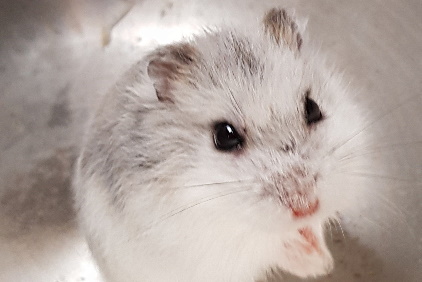Winter White Hamster Environment
Large Winter White Hamsters can live safely in a normal barred cage once adult, but smaller animals and juveniles can escape most barred cages. A tank or large enough bin cage can be used as an alternative as long as provide adequate ventilation through meshed lids and sides.
Winter White hamsters are best kept alone unless by experienced keepers. They can cohabit with siblings, but fallouts can become severe very quickly.
Cage Size
80 x 50cm is often considered the minimum cage space, with this being composed of unbroken floor space. Whilst bigger is often better, each hamster's individual circumstances should be taken into account. Some hamsters can become overwhelmed and stressed in larger cages, even if suitably filled with substrate, enrichment and hiding space.
Keep an eye on your pet's behaviour and be alert for signs of stress such as freezing, disjointed movements, excessive hiding and staying close to cage edges. Sometimes it can help to have a new or young animal in a smaller cage and increase the size of this once you have worked with them on their confidence and they have become familar with the noises and scents of their wider environment.
Pet shops woefully underestimate the suitability and size requirements needed for rodents so please do not be conned into buying tiny tanks or modular systems. Rotastak is not suitable for any rodent. For reasons why see our article on Why Modular Systems are Bad for your Pet.
Cage Types
- Wire cages: these give excellent ventilation and are good for climbing. You can hang plenty of toys from various positions and can interact with your animal through the bars. They can be quite difficult to clean. They provide much better opportunities for taming and enrichment. Bar spacing needs to be 1cm or less to prevent escapees and much less for smaller adults and juveniles.
- Glass tanks: - needs work to allow climbing material and are much more difficult to interact with your hamsters as they will consider hands from above very predatory. Very easy to clean but have poor ventilation. Do not use these with the standard heavy lids for fish - a staple gun, some 1mm wide wire mesh and bits of wood can easily make a decent lid to allow more air to pass through.
- a RUB: - if you are taking in rescues or money is an issue a plastic storage box can be converted into a RUB container for rodents. You must mesh top and all sides to allow adequate ventilation and ensure you go for a size that meets minimum unbroken floorspace requirements.
Substrate and bedding
Sawdust, or anything pine or cedar based should not be used since it can affect the lungs of mice and cause respiratory problems. Items such as Carefresh are quite good and absorbent, whilst still allowing space for burrowing. A cheaper alternative for this is to get a horse bedding such as MegaZorb.Other suitable substrates include Ectopetbed, Bedmax, bedexcel and finacard.
Timothy hay can be given to hamsters as it is soft enough to be safe for cheek pouches and contains high fibre. Do not offer other types of hay or straw as these can damage cheek pouches.
Fluffy bedding is extremely dangerous for hamsters as it can tangle in limbs and causes problems if eaten. Recycled shreds of paper or strings are good for nesting.
Toys and Nests
Wooden and plastic toys are suitable for hamsters, providing you don't have an obsessed chewer. Wooden items retain scent more and do need more frequent cleaning but they will provide better enrichment as they are safer to chew than plastic.
Bendy bridges, ladders, cardboard and plastic tubes are all good additions. Some hamster enjoy a shallow dish with a sandbath in for washing. This needs to be offered once a week or cleaned regularly if left in fulltime.
Some commercially available toys are not suitable for pets as they are composed entirely of sawdust which is dangerous for your pet to digest.
Your hamster must have multiple nesting sites available, coconut shells, wooden houses and fabric items are also fine. You can also hang fabric ropes and pet-safe hammocks. These must be washed regularly and checked frequently and trimmed of any dangerous loose threads.
Wheels
Wheels must be solid-based and not have spokes. Your hamster needs to be able to run easily without an arched back, with 8 inches being a good size for this. Hamsters benefit greatly from wheels and can also enjoy flying saucer type wheels. Occasionally, a hamster can develop an obsession and run on the wheel so much that it loses weight - if your pet develops this habit it may be a sign that they do not have other alternatives for enrichment. It would be important to reduce the time that the wheel is located in the cage and add interesting alternatives until the habit is broken.

